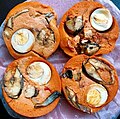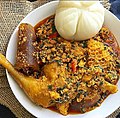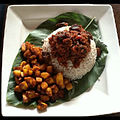Yoruba cuisine: Difference between revisions
CSV import Tags: mobile edit mobile web edit |
CSV import |
||
| Line 35: | Line 35: | ||
{{food-stub}} | {{food-stub}} | ||
<gallery> | |||
File:A_aro_and_Fish.jpg|A_aro and Fish | |||
File:Moi_moi_with_fresh_fish_and_boiled_egg.jpg|Moi moi with fresh fish and boiled egg | |||
File:Egusi_soup_with_pounded_yam_and_assorted_meats.jpg|Egusi soup with pounded yam and assorted meats | |||
File:Ofada_rise_with_fried_plantain_and_beaf.jpg|Ofada rice with fried plantain and beef | |||
File:Delicacies_in_Yoruba_land,_Nigeria.jpg|Yoruba cuisine | |||
</gallery> | |||
Revision as of 04:59, 18 February 2025
Yoruba cuisine is the traditional cuisine of the Yoruba people who are native to the southwestern part of Nigeria and parts of Benin and Togo. The cuisine is rich, diverse, and heavily reliant on locally sourced ingredients, reflecting the agricultural practices and cultural traditions of the Yoruba people. This article explores the staples, popular dishes, and cooking methods that define Yoruba cuisine.
Ingredients
Yoruba cuisine makes extensive use of various grains, legumes, vegetables, and meats. Key ingredients include:
- Yam: A staple food, often pounded into a smooth, sticky dough called Pounded yam.
- Cassava: Processed into gari, Fufu, and Lafun, serving as accompaniments for soups and stews.
- Beans: Particularly black-eyed peas, used in dishes like Moin-moin and Akara.
- Plantains: Both ripe and unripe plantains are used in various dishes.
- Palm oil: A common cooking oil that adds a distinctive red color and flavor to dishes.
- Vegetables: Including spinach, pumpkin leaves (Ugu), and waterleaf, used in soups and stews.
- Pepper: Such as Scotch Bonnet, used to add heat to dishes.
Popular Dishes
Yoruba cuisine boasts a variety of dishes, each with its unique preparation and taste. Some of the most popular include:
- Amala and Ewedu: Amala is made from yam flour or cassava flour and served with Ewedu soup, made from jute leaves.
- Jollof Rice: A one-pot rice dish cooked with tomatoes, onions, and peppers.
- Ofada Rice and Ayamase: A locally grown variety of rice served with a spicy green pepper sauce.
- Efo Riro: A rich vegetable soup made with spinach, meat, fish, and palm oil.
- Gbegiri and Ewedu: Soups commonly served with Amala, where Gbegiri is a bean soup.
Cooking Methods
Yoruba cooking methods are diverse, including boiling, grilling, frying, and roasting. Traditional cooking is done over an open fire or with charcoal stoves. Pounded yam, for example, is made by boiling yams and then pounding them until they reach a smooth and elastic consistency. Soups and stews are often started by preparing a base of blended peppers, onions, and tomatoes, to which various proteins and vegetables are added.
Cultural Significance
Food in Yoruba culture is not just sustenance but also a way to celebrate, show hospitality, and preserve traditions. Festivals, weddings, and naming ceremonies often feature elaborate meals prepared with specific dishes that have cultural significance. For example, offering kola nuts is a traditional way to welcome guests.
Conclusion
Yoruba cuisine is a testament to the rich cultural heritage of the Yoruba people. Its diverse ingredients, flavorful dishes, and traditional cooking methods offer a unique culinary experience that is integral to the social and cultural fabric of Yoruba society.
-
A_aro and Fish
-
Moi moi with fresh fish and boiled egg
-
Egusi soup with pounded yam and assorted meats
-
Ofada rice with fried plantain and beef
-
Yoruba cuisine




